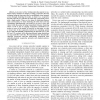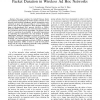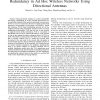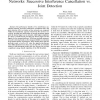428 search results - page 14 / 86 » Cooperative and opportunistic transmission for wireless ad h... |
INFOCOM
2011
IEEE
12 years 11 months ago
2011
IEEE
Abstract—Low power ad hoc wireless networks operate in conditions where channels are subject to fading. Cooperative diversity mitigates fading in these networks by establishing v...
WCNC
2010
IEEE
13 years 11 months ago
2010
IEEE
—This paper considers the tradeoff between bursty and continuous transmissions in wireless ad hoc networks. In our network model, packets belonging to specific transmitters arri...
MOBIHOC
2004
ACM
14 years 7 months ago
2004
ACM
Transmission power control (TPC) has a great potential to increase the throughput of a mobile ad hoc network (MANET). Existing TPC schemes achieve this goal by using additional ha...
WCNC
2008
IEEE
14 years 1 months ago
2008
IEEE
—Using directional antennas to conserve bandwidth and energy consumption in ad hoc wireless networks has attracted much attention of the research community in recent years. Howev...
ICC
2009
IEEE
14 years 2 months ago
2009
IEEE
Abstract—The performance benefits of two interference cancellation methods, successive interference cancellation (SIC) and joint detection (JD), in wireless ad hoc networks are ...




